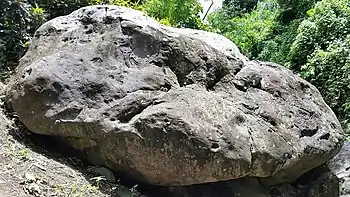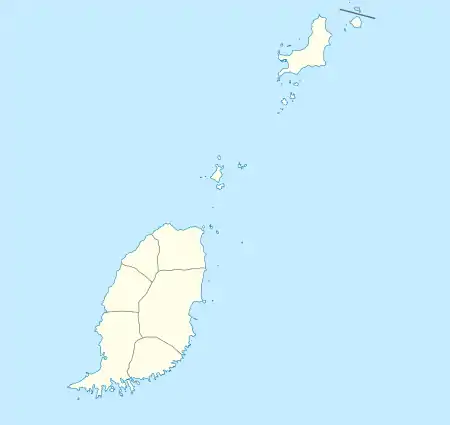Mt. Rich Petroglyphs
The Mt. Rich Petroglyphs are a series of pre-Columbian petroglyphs, set deep in a ravine along the Saint Patrick River in Mt. Rich, Grenada. The site consists of several boulders carved by ancient Amerindians, the largest of which contains over 60 engravings.[1] Two "workstones" can also be found nearby, comprising six cupules.[2]
 Main stone at the Mt. Rich Petroglyphs | |
 Shown within Grenada | |
| Location | Mt. Rich, St. Patrick Parish, Grenada |
|---|---|
| Coordinates | 12°11′36.28″N 61°38′34.47″W |
| Type | Petroglyph |
| History | |
| Periods | Late Ceramic Age/Troumassoid Period (AD 700-1500) |
| Cultures | Indigenous peoples of the Caribbean |
| Site notes | |
| Ownership | Mixed public and private |
| Public access | Yes |
| Website | http://www.mycedo.org |
History
Given the diversity and sheer number of images (which may be well over 60),[1] some researchers have hypothesized they represent a palimpsest of drawings carved at different times. For instance, a study of the design elements in the Mt. Rich petroglyphs, as compared to others in the Lesser Antilles, found that the earliest images at Mt. Rich may have been carved as early as AD 500.[3] However, ceramic data from a nearby archaeological site (Montreuil) suggests they were carved slightly later, no earlier than AD 700,[4] which is further supported by a radiocarbon dating.[5] Other proxy evidence correlating a period of climatic aridity with population movements in South America and the southern Caribbean suggest most (if not all) of Grenada's rock art and workstones date between AD 750-900.[6]
.png.webp)
The earliest historical reference to the Mt. Rich stones is a brief note dated 1833 in the Grenada Magazine, which describes "several hieroglyphical characters" carved on a stone below the Mount Rich sugar‐works.[7] In February 1903, German geologist Karl Sapper visited several of Grenada's petroglyph sites with Rev. Thomas Huckerby, drawing a few of the images of Mt. Rich in his book on St. Vincent.[8] In 1921, Thomas Huckerby, the Methodist minister who had hosted Sapper and previously written an article on St. Vincent's petroglyphs,[9] published a small booklet about Grenada’s petroglyphs through the Museum of the American Indian in New York (now part of the Smithsonian).[10] The 1921 report contains photographs and discussion of the glyphs at Mt. Rich and two other sites near Victoria, Grenada. Since Huckerby's visit, several researchers have mentioned the site in their reports.[4][11][12][13][14]
In 1986, Archaeologists Ann Cody recorded Mt. Rich in an inventory of the island's prehistoric sites.[12] They observed that Huckerby's photographs did not match the current position of the main stone, leading them to hypothesize that the rock had rolled down the hill after Huckerby’s visit. Others have since noted that, given its association with the other petroglyphs and workstones in the river, the main stone likely just moved slightly out of position since 1921, perhaps a result of people standing on top.[14] Indeed, the 1833 article describes the stone as situated below the Mt. Rich sugar estate, indicating it was probably always in the ravine.
Interpretation

While the original meaning of the Mt. Rich engravings can only be speculated, archaeologists have made several observations about rock art in the Caribbean, generally:[15]
- they always occur near water;
- there are often "workstones" nearby;
- some images occur on ceramics, but most do not;
- there are three general categories: simple faces, elaborate faces, and geometric patterns;
- the elaborate faces often have zoomorphic (animal-like) features.
Most Caribbean archaeologists hold that petroglyphs were drawn by shamans, perhaps to denote places where ancestors would gather.[16] Like much of the New World, Amerindian groups in the Caribbean were animists, and sought to communicate with their ancestors. If petroglyphs are ritual spaces, then the accompanying workstones may be mortars upon which the shamans mixed hallucinogenic concoctions to connect with the ancestors before carving (or re-carving).[17]
Visiting
In 2014, a local youth group (MYCEDO) received a grant to renovate an old lookout building and turn Mt. Rich into a heritage attraction.[18] In 2018, they opened the building to visitors, offering information and a viewing platform for a small fee. The group also conducts tours of their village and the abandoned plantation estates nearby.[19][20] The Mt. Rich Petroglyphs are also part of the Ministry of Tourism's Petroglyph Path tour, which links several of Grenada's rock art sites.[21][22]
Official Status
Like all of Grenada's prehistoric and historic archaeological sites, there are no clear designations or regulations protecting the Mt. Rich site,[23] despite being consistently recommended for listing on a national register of heritage sites (which has never been formalized).[24][25] Technically, all these sites are protected under Grenada's National Museum Act of 2017, but this Act has only been partially implemented by the Government of Grenada.[23][26]
Related
References
- "Mt Rich Grenada (Caribbean)". Megalithic Portal. July 7, 2010. Retrieved 15 January 2018.
- Allen, Casey; Groom, Kaelin (2013). "Evaluation of Grenada's "Carib Stones" via the Rock Art Stability Index". Applied Geography. 42: 165–175. doi:10.1016/j.apgeog.2013.02.007.
- Jonsson Marquet, Sofia (2009). "Contextual Analysis of the Lesser Antillean Windward Islands Petroglyphs". In Hayward, Michele H.; Atikinson, Lesley-Gail; Cinquino, Michael A. (eds.). Rock Art of the Caribbean. Tuscaloosa: University of Alabama Press. pp. 147–160. ISBN 9780817355302.
- Petitjean Roget, Henry (1981). Archaeology in Grenada. Barbados: Caribbean Conservation Association. OCLC 499476858.
- Hanna, Jonathan A. (2019). "Camáhogne's Chronology: The Radiocarbon Settlement Sequence on Grenada". The Journal of Anthropological Archaeology. 55: 101075. doi:10.1016/j.jaa.2019.101075. S2CID 198785950.
- Hanna, Jonathan A. (2018). "Grenada and the Guianas: Demography, Resilience, and Terra Firme during the Caribbean Late Ceramic Age". World Archaeology. 50 (4): 651–675. doi:10.1080/00438243.2019.1607544. S2CID 182630336.
- "Relics of the Charib Indians in the Island of Grenada". The Grenada Magazine. I (II): 47. February 1833.
- Sapper, Karl (1903). St. Vincent. Hildburghausen: Bibliographischen Institut. p. 381. OCLC 82624388.
- Huckerby, Thomas (1914). "Petroglyphs of St Vincent, British West Indies". American Anthropologist. 16 (2): 238–244. doi:10.1525/aa.1914.16.2.02a00040.
- Huckerby, Thomas (1921). Petroglyphs of Grenada and a recently discovered petroglyph in St. Vincent. Indian Notes and Monographs. Vol. 1. New York: Heye Foundation, Museum of the American Indian.
- Bullen, Ripley P. (1964). The Archaeology of Grenada, West Indies. Contributions of the Florida State Museum: Social Sciences. Gainesville: University of Florida. OCLC 495548996.
- Cody, Ann (1986). Archaeological Site Records. St. George’s, Grenada: on file at the Grenada National Museum.
- Dubelaar, C.N. (1995). "Grenada". The petroglyphs of the Lesser Antilles, the Virgin Islands, and Trinidad. Amsterdam: Natuurwetenschappelijke Studiekring voor het Caraïbisch Gebied. pp. 46–89. ISBN 978-90-74624-05-3. OCLC 905778960.
- Hanna, Jonathan (2017). The Status of Grenada's Prehistoric Sites: Report on the 2016 Survey and an Inventory of Known Sites. Botanical Gardens, Grenada. pp. 161–164. doi:10.18113/S1QG64.
{{cite book}}: CS1 maint: location missing publisher (link) - Hayward, Michele H.; Atikinson, Lesley-Gail; Cinquino, Michael A., eds. (2009). Rock Art of the Caribbean. Tuscaloosa: University of Alabama Press. ISBN 9780817355302.
- Wild, Kenneth (2003). "Defining Petroglyphs from the Archeological Record" (PDF). Proceedings of the XXI International Congress for Caribbean Archaeology. Santo Domingo, Dominican Republic: IACA. Retrieved 16 January 2018.
- Pagan-Jimenez, Jaime R.; Carlson, Lisabeth (2014). "Recent archeobotanical findings of the hallucinogenic snuff Cohoba (Anadenanthera peregrina (L.) Speg.) in precolonial Puerto Rico". Latin American Antiquity. 25 (1): 101–116. doi:10.7183/1045-6635.25.1.101. S2CID 164085527.
- "MAREP Conducts Training". NowGrenada. 13 November 2014. Retrieved 16 January 2018.
- Campbell, Curlan (1 March 2018). "Amerindian burial site under siege". NowGrenada. Retrieved 27 June 2021.
- "MYCEDO". Retrieved 16 January 2018.
- "Petroglyph Path [MOT/GOG web]". Retrieved 27 June 2021.
- "Petroglyph Path [GrenadaArchaeology web]". Retrieved 16 January 2018.
- Byer, Amanda (2021). "Appendix: An Overview of the Laws Governing Archaeological Heritage in the English- and Spanish- Speaking Caribbean". In Ostapkowicz, J.; Hanna, J. (eds.). Real, Recent, or Replica: Pre-Columbian Caribbean Heritage as Art, Commodity, and Inspiration. Tuscaloosa: University of Alabama Press. pp. 256–272. ISBN 9780817320874.
- OAS (1988). Plan and policy for a system of national parks and protected areas in Grenada and Carriacou (PDF). Washington, D.C.: General Secretariat of the Organization of American States, Executive Secretariat for Economic and Social Affairs, Dept. of Regional Development. Retrieved 27 June 2021.
- Turner, Mel (2009). Grenada Protected Area System Plan. Vancouver, BC: Environment and Sustainable Development Unit (ESDU) of the Organization of Eastern Caribbean States (OECS).
- "de la Mothe: I was not evicted". Grenadian Voice. 25 November 2020. Retrieved 27 June 2021.